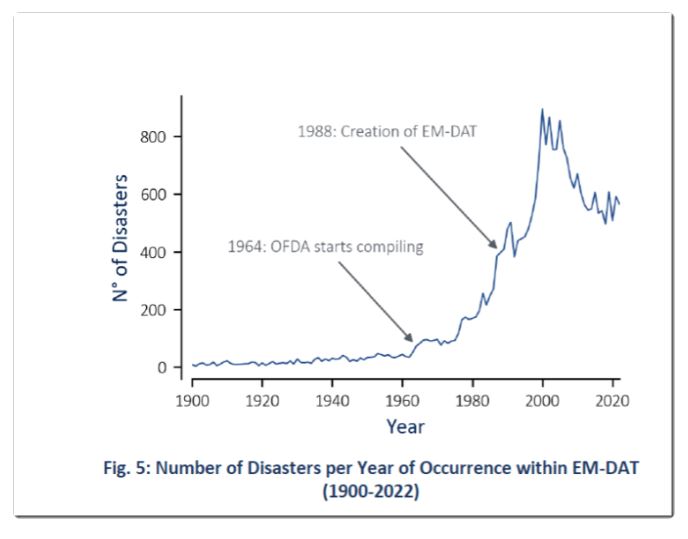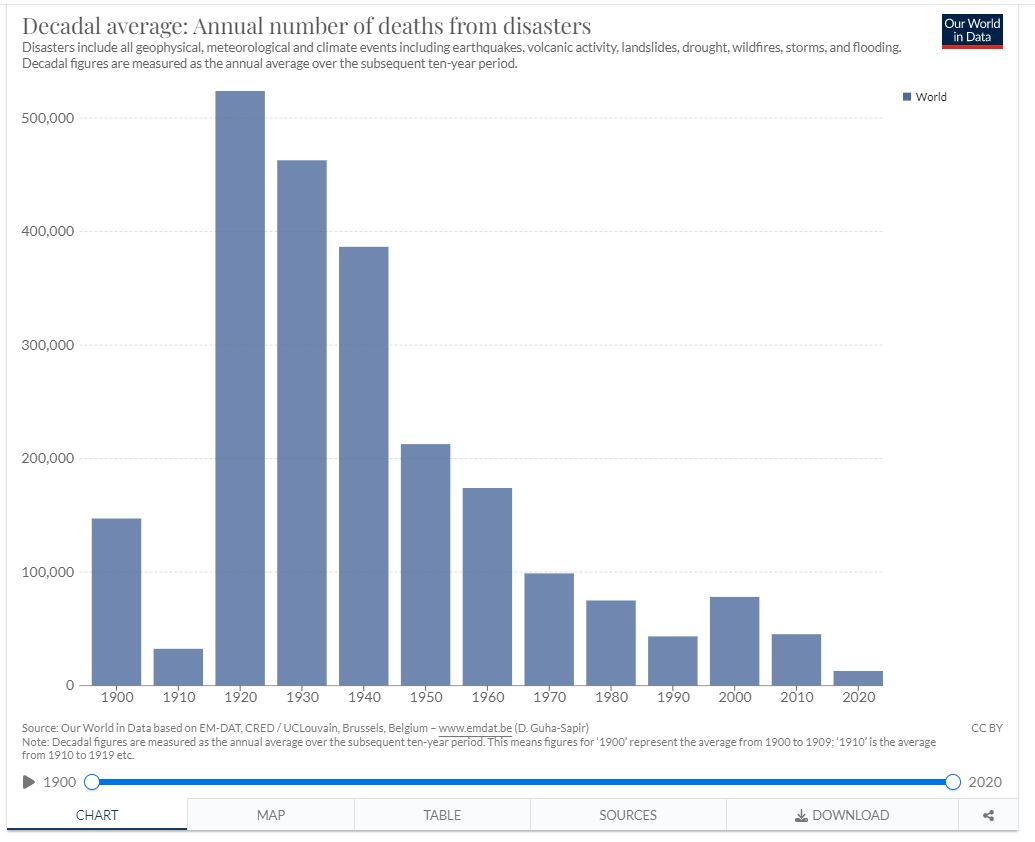July 18, 2023
It turned out that the number of natural disasters in the world is decreasing, not growing. Perhaps it never grew. As opposed to the endless statements to the contrary by the UN and many other organizations, the "bold" figures show: natural disasters in the XXI century are becoming less and less.
Until the 1960s, no one specifically counted the number of natural disasters in the world. Therefore, the planet as a whole often remained unaware of the events in Africa and Asia, which made it difficult to assess the situation with the number of victims of the disaster. Against such a background, it was impossible to understand what measures people should take to combat them. Therefore, in 1973, the Centre for the Study of the Epidemiology of Natural Disasters was established in Belgium - the world's leading organization for accounting for such events, which has been actively cooperating with WHO since 1980.
 Last July, this organization released the anniversary issue of its CRED Crunch publication, where it presented the indicators of how the number of natural disasters changed during the observation period, which had not previously been circulated. The issues contained absolutely unexpected conclusions: the number of such events peaked at the end of the XX century, and has been declining since then, and by 2021 they became one and a half times less frequent than they were at the end of the 1990s.
Last July, this organization released the anniversary issue of its CRED Crunch publication, where it presented the indicators of how the number of natural disasters changed during the observation period, which had not previously been circulated. The issues contained absolutely unexpected conclusions: the number of such events peaked at the end of the XX century, and has been declining since then, and by 2021 they became one and a half times less frequent than they were at the end of the 1990s.
This utmost seriously contradicts with the official position of the UN on the issue: according to UN, due to global warming, the number of such disasters, on the contrary, is constantly growing, mainly due to climate change. And not only all environmental organizations, but also the Centre for the Study of the Epidemiology of Natural Disasters - after all, it is this centre who administers the world Database of emergency registration (The Emergency Events Database, EM-DAT) present the same state of affairs. This is the universal standard of recording natural disasters, from which both the UN and WHO, and in general, everyone who addresses the issue of the frequency of disasters, use as the base for information. Actually, there are no other global databases of this kind. How was such a contradiction possible?
 The publication of the Centre explains this. The point is that EM-DAT was established only in 1988, and during the first few years, they only streamlined the collection and systematization of data on disasters around the world, which is why they were extremely incomplete. Then they managed to achieve for full functioning of the system and began to fully register such events. Therefore, the sharp increase in the number of natural disasters from the 1960s to the end of the XX century is primarily due to the increase in the registration of such events as a whole, and not to the fact that they have become more frequent. For the last quarter of a century, when the registration is sufficiently complete, there is no increase in the number of disasters, but there is a very significant decrease in them.
The publication of the Centre explains this. The point is that EM-DAT was established only in 1988, and during the first few years, they only streamlined the collection and systematization of data on disasters around the world, which is why they were extremely incomplete. Then they managed to achieve for full functioning of the system and began to fully register such events. Therefore, the sharp increase in the number of natural disasters from the 1960s to the end of the XX century is primarily due to the increase in the registration of such events as a whole, and not to the fact that they have become more frequent. For the last quarter of a century, when the registration is sufficiently complete, there is no increase in the number of disasters, but there is a very significant decrease in them.
The publication clarifies a rather strange combination of circumstances. The point is that the main causes of natural disasters - cyclones, which usually occur in the tropical areas, and floods and fires - are observed less and less in the world. Not only the frequency of tropical cyclones, but also their total energy is falling. The scholars explain this by global warming. It reduces the temperature difference between low and high latitudes, and it determines the overall energy resource of cyclones.
In parallel to this, the world is watching the drop in the strength of floods (also due to warming, which increases evaporation), as well as in the number of so-called wildfires (this is mainly due to changes in agricultural practices). Therefore, it has been a mystery for many years how the number of natural disasters from global warming can grow at all, while their main causes are suppressed by the same warming or other anthropogenic factors.
 New data cleans this contradiction away: the number of disasters is really falling, which may partly explain the decrease in the number of their victims. We should recall that the last decade shows the lowest number of disaster victims per a time unit in the entire history of observations (and not only per capita, but also in absolute numbers).
New data cleans this contradiction away: the number of disasters is really falling, which may partly explain the decrease in the number of their victims. We should recall that the last decade shows the lowest number of disaster victims per a time unit in the entire history of observations (and not only per capita, but also in absolute numbers).
However, an even more significant cause for the decline in the death toll in such situations is economic growth, which allows people to build stronger houses and evacuate faster from disaster zones in the locations, where they threaten their lives.
It is highly probable that the new data of the Centre will remain unknown to the general public, because neither the UN, WHO, nor the WMO (World Meteorological Organization) will want the theses repeatedly declared by their experts that the number of natural disasters is allegedly growing to be questioned and suspected. And the mass-media is unlikely to seriously cover such an event, for people almost always read the news "on fear" very well, but the refutations of such publications are not so much popular among them.
Sources:
https://naked-science.ru/article/climate/chislo-stihiinyh-bedstvii-padaet
Translated in English by Muhiddin Ganiev